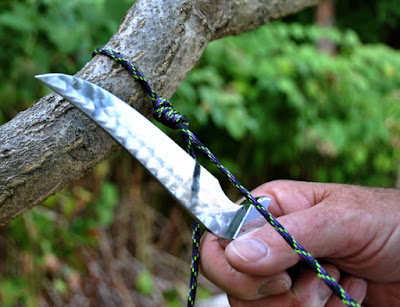It’s hard to understand what draws me to box openers. It wasn’t the stock boy job I had in high school. It wasn’t so great that I want to remember the daily grind. There were a few things that stayed with me. Like the time a can of White Rain hair spray went off in the cardboard incinerator or the stack of pickle jars that got away from me. What a mess that was! Pickles and broken glass everywhere!
I suspect it is the variations of a basic tool that I enjoy. You could simply grab the sealed flaps of a box and rip it open. I don’t know how many times you could do that in a day while stocking shelves before you wore yourself out, so cutting was the way to go. Besides, many stores want to cut the packing box so to make a shallow tray so hard-to-stack cans could be layered on the shelf.
 |
| The front of the box cutter. Note how the guard covers the single edge razor blade. |
Then there’s the graphics on the side of the box cutter. Some are rather nice and some remind us of products we knew as a child but never survived the great product wars to grow into adulthood with us.
I picked up a nice Ry-Krisp box cutter made by Bailey Beschta out of California the other day. All I could find about the Bailey Beschta company was they were incorporated in California on Feb 7 1955. Ralston Ry-Krisp just recently went out of business, but there’s an internet buzz that a group of investors may try to pump a little life back into the crackers.
 |
| Slightly roached back. Ry-krisp were made by the Ralston Cereal company. |
One side of the box cutter looks a little roached (that term from American Pickers is creeping into my vocabulary!), but it is the aluminum blade guard that caught my attention.
The cutter uses a single edge safety razor that is not retractable. Instead a spring loaded guard protects the blade’s edge. Pressure against the box would swing the guard out of the way and expose the working edge. The cutter is set up with a hold so you could suspend the box cutter from your wrist, freeing you to pick up product and place it on the shelf.
 |
| If it was black and assisted opening, it would be TACTICAL and you could charge more for it. |
I also purchased a Sheffield utility/box cutter. It’s the older style, non-spring assisted opener. It locks open with a spine lock and is missing the stud to thumb it open, but it does sport a pocket clip. The clip is not reversible and holds the knife tip down in your pocket. This knife uses a utility blade instead of a single edge razor blade. It’s significantly heavier than the Ry-Krisp cutter, so it’s up to heavier usage.
I bought this chiefly to round out my collection with an example of current box opening technology.
 |
| The clip is set up for tip down carry. I', sure it could be drilled and tapped to reverse the clip of either side. Note: Fingers are original equipment. |
Both were a little dirty when I got them. A wipe down with a little warm water followed by a good spray with WD-40 and another wipe down cleaned them up quite nicely.
If you know anything about the Bailey Beschta Company, I’d be happy to add your comments.


























